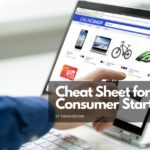When Christina was younger, she loved fashion and dreamed of starting her online clothing brand. Now a young adult, she’s finally making her dream a reality, but she doesn´t know where to start. So she opened her notebook and googled “how to start an online clothing brand.” Are you familiar with that? Then this post is for you!
Starting an online clothing brand can be an enriching experience, as it allows you to have total creative control over your business. However, before you get started, there are a few things you need to know. Let’s get right into it!
- How Big is the Ecommerce Fashion Industry?
- Two famous fashion brands
- 7 Exploding Fashion Keywords
- What is a Clothing Brand?
- What are the Characteristics of a Brand?
- What are the Benefits of a Brand?
- The Different Types of Branding
- How to Create a Brand Identity
- The Brand Message
- The Brand Experience
- The Brand Values
- The Brand Story
- The Brand Logo
- The Branding Materials
- The Brand Website
- The Brand Promotion
- Conclusion
How Big is the Ecommerce Fashion Industry?
By 2025 the worldwide market value for apparel, accessories, and footwear is estimated to be $1 trillion. The compound annual growth rate is expected to be 7.18%, and the average revenue per user (ARPU) in the U.S. for apparel in 2019 was $432. [Common Thread]. Although there is lots of competition, there is also lots of room for new brands.
Two famous fashion brands
Let´s have a look at the stories of two famous fashion brands.
Zara
Inditex runs the brand Zara and its market capitalization amounts to $111 billion. The company was founded by Amancio Ortega in 1963 in Spain and it took ten years to grow to 500 employees.
The company’s mission was to provide a link between runway fashion and the customer, by bringing the customer closer to the company’s product range and style trends at an affordable price.
The first Zara store opened in 1975 in A Coruna. In 1983, Zara expands across Spain and opens nine stores. 1988 is the year, when Zara went international, opening a Zara store in Porto, Portugal. In 1989, Zara jumps over the Atlantic and starts a new store on Lexington Avenue, New York. They continued their worldwide expansion and the rest is history.
The company completely redefined its 4Ps marketing plan with a 4Es strategy that puts the customers in focus. Instead of Product, Price, Promotion, and Place, Zara emphasized the ‘Experiences’ for the customer, value proposition it ‘Exchanges’ with the customers, ‘Evangelism’ with the help of the customer, and being in ‘Every place’ for the customer.
Zara profits heavily from email marketing and other marketing experts follow Zara´s email campaigns.
Nike
Nike was founded in 1964 in Beaverton, United States by Bill Bowerman, a track-and-field coach, and his former student Phil Knight.
The first store was opened in 1966 and the brand Nike was launched in 1972. Early in the 2000s, Nike had retail outlets and representatives in over 170 countries, and its logo, a curved check mark called the “swoosh,” was well-known throughout the world. Nike’s entrepreneurial acumen is derived from its receipt of endorsements by such athletes as Michael Jordan, Mia Hamm, Roger Federer, and Tiger Woods.
NikeTown’s outlets, the first of which opened in 1990, celebrate these athletes and others by presenting the public with a variety of Nike merchandise.
The Nike marketing team has also been turning to email as an essential part of their online marketing strategy. By growing your audience through your email list, you can later easily follow up with those customers. Also, email makes it easy to keep your existing customers aware of upcoming merchandise releases.
Today, Nike is the second largest fashion brand behind Inditex with a market capitalization of $92 billion.
7 Exploding Fashion Keywords
To discover hot trends in the fashion industry, Google keyword research is a valuable strategy. Here are 7 fashion-related keywords, that show exploding trends:
- manscaped – 246,000 searches per month, 7,400% growth. Grooming products for men.
- palm angels – 201,000 searches per month, 3,150% growth. A fashion brand that comes from a photography book.
- baguette – 135,000 searches per month, 670% growth. Small Fendi handbag, that plays with the French breadstick of the same name.
- cow print – 74,000 searches per month, 822% growth. Design mimicking large black cow flecks on a white background.
- pepper bra – 33,100 searches per month, 525% growth. Better fitting bras for women with small cup sizes.
- aime leon dore – 49,500 searches per month, 1566% growth. Fashion and lifestyle brand from New York with focus on “simple yet powerful” design.
- overshirt – 5,400 searches per month, 523% growth. A shirt that is worn over another shirt.
To gain a deeper understanding of branding, lets find out more about the characteristics of a brand.
What is a Clothing Brand?
A clothing brand is a company that manufactures and sells clothing. The company typically has a name, logo, and slogan. Clothing brands may also sell other products, such as accessories, home goods, or fragrances.
What are the Characteristics of a Brand?
Brands are created to differentiate a company’s products from its competitors. They are identifiers that make an emotional connection with consumers and can build loyalty. A successful brand can create an association with a positive attribute, such as quality or value. It must be memorable, and consumers must be able to identify it quickly. Customers, story, values, design, sourcing, quality, price, function, community, stores, or products, can all be part of a brand.
What are the Benefits of a Brand?
There are a few key benefits that come with having a solid brand. First, a well-recognized and well-loved brand can help attract new customers and keep current ones coming back. Additionally, a powerful brand can be a significant asset in times of recession or tough competition, as it can help set a company apart from the rest. Additionally, a well-recognized brand can signal to consumers that a product or service is high quality. Finally, you can charge a higher price for a product that belongs to an established brand.
The Different Types of Branding
Branding is one of the most important aspects of any business, big or small. But what is branding, exactly? And what are the different types of branding?
Brand identity is the overall image of a company or product. It encompasses everything from the company name and logo to the colors used in marketing materials and the tone of voice in advertising.
There are three main types of brand identity: visual, verbal, and emotional. Visual branding is all about the visuals associated with a company or product, such as the logo, colors, and typeface. Verbal branding is all about describing a company or product, such as the tagline, mission statement, and values. Emotional branding is about creating an emotional connection with consumers, often through marketing campaigns that tug at people’s heartstrings.
How to Create a Brand Identity
A company’s brand identity is one of its most important assets. It’s what helps customers remember a company and its products, and it can be a significant factor in whether or not they do business with that company again. There are many ways to create a brand identity, but the most important thing is to ensure it’s consistent across all channels. Here are a few tips for creating a strong brand identity:
1. Start by developing a clear mission and vision for your company. This will help you determine your brand identity’s overall tone and feel.
2. Choose colors and fonts that reflect your company’s values and personality.
3. Make sure your branding is consistent across all channels, from your website to your marketing materials to your social media profiles.
4. Come up with a tagline or slogan that encapsulates what your company represents.
The Brand Message
A strong brand message can help a company stand out from its competitors and create a loyal customer base. Many different factors go into making a successful brand message, and it is essential to consider all of them when developing a strategy.
One of the essential elements of a brand message is its tone. The tone should be consistent with the company’s values and reflect the target audience’s needs and wants. It is also essential to be clear and concise in communicating the brand message and ensuring that all marketing materials are on-brand.
Developing a successful brand message takes time and effort, but it can be well worth it in the long run. Businesses can set themselves apart from the competition and build lasting customer relationships by creating a powerful brand identity.
The Brand Experience
The brand experience is the sum of all the interactions a customer has with a brand. This includes everything from the initial advertising that draws a customer into the customer service they receive when they have a question or problem. The brand experience also consists of the feelings customers have when they think about the brand, both positively and negatively. Creating a consistent and positive brand experience is essential for any business, as it can help build customer loyalty and increase sales.
The Brand Values
Brand values are the underlying principles that a company uses to make decisions about its products and services. These values can be based on a wide variety of factors, such as social responsibility, environmentalism, or customer service. A company’s brand values help to create a unique identity for its products and can be a major factor in distinguishing them from competitors.
The Brand Story
The brand story is the tale that a company tells about itself. It is used to create a sense of identity and connect customers with its products or services. The story can be complex or straightforward, but it should be engaging and memorable. It can attract new customers, retain existing customers, and inspire employees.
The Brand Logo
The brand logo is a graphic representation or symbol used to identify a company’s products and services. The emblem is often displayed on the company’s packaging, advertising, and other promotional materials. A well-designed logo can help consumers quickly and easily identify a product or company. A logo should be simple, memorable, and versatile enough to be used in various marketing materials.
The Branding Materials
Branding materials serve as the foundation for a company’s marketing efforts and help to create a consistent and recognizable brand image across all channels. They can include anything from logos and trademarks to fonts, colors, and pictures. To be effective, branding materials must be consistent with the company’s overall message and target audience.
The Brand Website
A brand website is a website that is dedicated to a specific brand. It typically contains information about the brand, such as its history, the products that the brand offers, and how to purchase the products. The brand website may also contain marketing materials, such as videos and images and customer service information.
The Steps to Build Your Clothing Brand Website
- Get webspace: To make your website available online, you need webspace on a server from a web hosting company. I recommend Bluehost, as I use and love this hosting service myself. With Bluehost, you can build a lightning-fast website at extremely low costs.
- Choose a domain: A web domain is a specific address on the internet where a website can be found. The domain name consists of two parts: the top-level domain and the second-level domain. The top-level domain is the broad category of the site, such as .com, .net, or .gov. The second-level domain is the specific name of the site, such as google.com or microsoft.net. With Bluehost you get a free domain for the first year.
- Install WordPress: WordPress is a content management system (CMS) that enables users to create a website or blog from scratch, or to improve an existing website. WordPress is free and open-source software released under the GPL. It is used by millions of people around the world, including many large organizations, such as The Guardian, Forbes, and The New York Times. With Bluehost the installation of WordPress is just one click.
- Choose a Theme: A WordPress theme is a design or layout for a WordPress site. It determines the overall look and feel of a website, from the font to the colors to the layout. There are thousands of different themes available, both free and premium, and users can install them with just a few clicks. I tried many different themes with widely different results. When I set up a website, I try to achieve two goals: First, I want a layout that looks nice and provides the feature I need for my purpose. Second, I want to achieve fast loading times. You should aim to reach a loading time of 2 to 3 seconds. Otherwise, you will lose lots of visitors before they even saw your website. If your website isn´t fully loaded after 3 seconds, you will lose 40% of visitors! Therefore I look around for a solid theme, and I found GeneratePress which I can highly recommend. The advantage of GeneratePress is its lightweight code, which enables super fast loading times. And you also get a whole library of different styles, from business to e-commerce to blog and more.
- Add Content: Next, you need to bring your clothing brand website to life and add your content. Tell your story, show your designs, and create engaging articles and videos.
The Brand Promotion
Brand promotion is a marketing technique companies use to create awareness for their brands and products. This can be done through various methods, such as advertising, public relations, and social media. By creating a solid brand presence, companies can hope to increase consumer loyalty and sales.
Email marketing should be one of your top priorities. It’s a great way to keep in touch with customers, announce new products, and build relationships with potential customers. A study showed, that $1 invested in email marketing generates a return of $42. Therefore, email marketing is one of the most profitable and effective ways to promote a clothing brand website.
Here are a few tips for effective email marketing:
1. Keep your emails short and to the point. Customers are more likely to read more straightforward emails, and they’re less likely to unsubscribe if they don’t have to scroll through a long message.
2. Use images sparingly. Too many images can slow down the loading time of your email, and many people now access their email on mobile devices, which can be slow to load images.
3. Make sure your links work properly. Nothing is more frustrating than clicking on a link in an email only to have it lead nowhere.
4. Keep your content fresh.
Which Email Provider do I Recommend?
To execute email marketing, you will need an email provider. I personally have been working with GetResponse for many years. Their platform offers powerful, simplified tools to send emails, and automate your marketing. And they offer a free-forever account for up to 500 contacts and unlimited newsletters. That´s the perfect package for starters!
Conclusion
Starting an online clothing brand is a great opportunity to build an online business. Creating your brand, building your website, and promoting your brand with email and more are the main tasks and it will take some effort to get started, but once you’re up and running, the sky is the limit. So what are you waiting for? Get started today!
Peter is a solopreneur in Salzburg, Austria, a husband, and a family father. He runs a little publishing company, and blogs about starting and running online businesses. In his spare time, he enjoys hiking with friends and reading the Bible, and sometimes he takes a trip in his roaring old black 2001 Jaguar XJ8.





